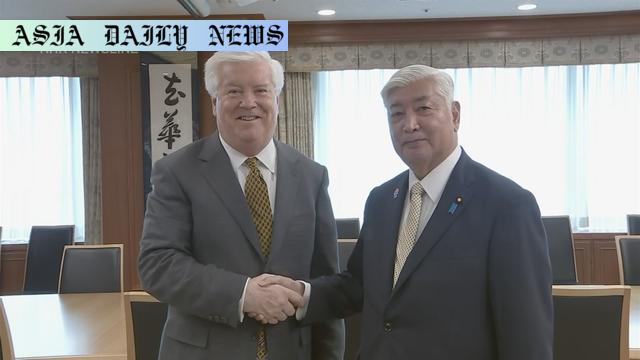US-Japan Alliance bolstered as defense leaders agree on upgrades to command systems, mutual trust, and cooperation.
- Japanese Defense Minister Nakatani Gen and US Ambassador George Glass agreed to enhance bilateral defense relations.
- Key developments include boosting command systems, joint drills, and advancing Japan’s Self-Defense Forces’ capabilities.
- The discussions also addressed improving cooperation in equipment and technology, with repairs for US vessels in Japan.
- Discipline measures for US military personnel in Okinawa were highlighted, addressing incidents involving service members.

Strengthening US-Japan Alliance: A Key Strategic Partnership
Introduction to the Key Developments
On Monday, Japanese Defense Minister Nakatani Gen and the newly appointed US Ambassador to Tokyo, George Glass, convened for their first meeting. The two leaders reaffirmed their shared commitment to strengthening the bilateral alliance between Japan and the United States. This meeting comes at a critical time, as both nations face mounting regional challenges that necessitate closer military and strategic cooperation.
Boosting Command Systems and Deterrence
One of the key outcomes of the meeting was the agreement to upgrade command and control frameworks, enhancing both nations’ ability to respond to potential security threats in the Indo-Pacific region. Joint military exercises were emphasized as a vital method for improving interoperability between Japan’s Self-Defense Forces and the US military. This collaborative approach aims to bolster deterrence capabilities and ensure sustained peace and stability in the region.
Advancing Cooperation in Technology and Equipment
In addition to tactical frameworks, Nakatani and Glass underscored the importance of technological advancements and infrastructure improvements. During a subsequent meeting with US Secretary of the Navy John Phelan, there was a commitment to enhance cooperation in the areas of equipment and technology. Specifically, discussions highlighted plans to establish a system allowing US military vessels to undergo repairs in Japan, a step forward in fostering greater logistical and operational collaboration between the two countries.
Addressing Discipline Issues in Okinawa
Concerns surrounding the activities of US service members in Okinawa also took center stage during the discussions. Minister Nakatani urged the US military to enforce stricter disciplinary measures, following recent incidents involving American Marines accused of sexual misconduct. Ambassador Glass assured his Japanese counterpart that the US side would address these issues appropriately, signaling a commitment to maintaining harmony between the two nations.
A Broader Vision of a Free and Open Indo-Pacific
Both leaders expressed their shared aspiration for a free and open Indo-Pacific. This vision forms the bedrock of Japan-US relations, particularly as threats to maritime security and territorial sovereignty persist in the region. By deepening mutual trust and working closely together, both nations aim to usher in a new era of cooperation and prosperity, reinforcing their roles as key allies in the global arena.
Conclusion
The reaffirmation of the US-Japan alliance signifies a renewed focus on mutual security, technological collaboration, and disciplined governance. These discussions not only address immediate concerns but also lay the groundwork for a lasting partnership that aligns with both nations’ strategic interests in the Indo-Pacific. As challenges in the region evolve, the steadfast alliance between Japan and the United States will undoubtedly remain a cornerstone of peace and stability.



Commentary
Reflections on the US-Japan Defense Collaboration
The Importance of Strategic Alliances
The recent meeting between Japanese Defense Minister Nakatani Gen and US Ambassador George Glass exemplifies the critical importance of international alliances in today’s complex geopolitical landscape. Japan and the United States share not only a history of collaboration but also a forward-looking vision for regional stability and prosperity. This meeting is a reminder of the need for nations to work together in addressing shared challenges and seizing mutual opportunities.
Focusing on Joint Security Measures
One of the most significant takeaways from the discussions was the emphasis on upgrading command systems and enhancing deterrence capabilities. With the Indo-Pacific facing increasing instability due to assertive actions by regional powers, these measures are timely. Joint military exercises serve as a cornerstone for preparedness and ensure that the US and Japan can respond effectively to a broad range of scenarios. This proactive approach demonstrates both nations’ commitment to defense and security.
Navigating Sensitive Issues in Okinawa
The discussion surrounding discipline issues in Okinawa reflects the challenges that arise when foreign military forces are stationed abroad. While such incidents can strain relationships, the willingness of Ambassador Glass to address these concerns head-on is commendable. Striking a balance between maintaining security cooperation and fostering goodwill among local populations will be essential for the longevity of the alliance.
Looking Ahead
As both countries reaffirm their bond, it is evident that the US-Japan alliance is more than a mere partnership; it is a cornerstone of stability in an unpredictable world. By focusing on shared goals such as a free and open Indo-Pacific, technological innovation, and joint preparedness, this relationship holds promise for enduring and mutually beneficial collaboration well into the future.